Nothing lasts forever. There comes a time when goals are made and hopefully met. The time to let go and move on allowing projects to sink or swim from the efforts of others comes to all personal goals eventually. Some successes evolve and grow in different directions over the years as expected and the goal is mostly about the journey. The challege becomes knowing when to let go and to what degree. This can be true of relationships, marriage, raising children, carreers, and in this case, public service community projects.
I rertired with a goal of combining my two passions in ways that promote the naureal world. When I moved away from the metro area of Northern Virginia to the ag-based mid-west in the early 1970s, I found my first real passion was in conservation shortly after graduating high school. I wanted to work for apubic service and tried at the local and state levels. After a couple years of concentrated efforts to be employed in that field, I discovered that the time for women would come later and it did without me. I did find my place of employment in local and state government with a 30 year carreer identifying value and became highly successful for my opinions. I have wrote about that extensively earlier in this blog when I was preparing for retirement.
When I did retire in 2011, I finally was in a position to combine my interests of gardening and conservation. I became a Missouri Master Gardener in 2012 and a Missouri Master Naturalist in 2014. I am currently a member of both but much less active this year. I attained Emeritus status as a Missouri Master Gardener in 2021. I reach the 500-hour Milestone award as a Missouri Master Naturalist in 2018. I have wrote extensively throughout this blog about all the projects I have been involved in as an active member of both state public service groups. It has been a good journey! The goals I had set from the beginning were met and it is now time for me to let go and allow others to carry on. I still have the same interests but different priorities for my time after about ten years of active public service in each group. I am happy that I kept such good records and photos to look back and enjoy for the rest of my life!
Now I would like to share the (likely) final post and photos I will publish in this blog about the Settlers Village Gardens in Wheatland, Missouri. This has been my main project since 2012 and my husband joined me when he became a Master Gardener in 2014. Together we alone were responsible for the planning and upkeep of the four main gardens. The buildings and supporting landscape are the responsibility of a separate local committe that has had much instability most of the years but appears stable now. I think my husband will let go when he attains emertitus status after one more year of service. We both will always be available for consultation and advice.
It is my hope that Settlers Village will continue as a historical place to visit in Wheatland. The buildings are not in good condition and likely not safe to allow the public inside anymore. A couple of the buildings have been removed due to deterioration and safety issues. The others may soon follow if major efforts and money are not put into stabilizing the buildings. There is less public interest each year now. Change is going to come one way or another sooner or later.
My interests in gardening and conservation continues to grow and together have reached my goals. There are a variety of Missouri native plants along with cultivers to produce gardens that are aesthetically pleasing to the public as well as attractive to a variety of birds, butterflies, bees, bugs, and pollenators. With the right soil mixture combinations and mulch, weeding and watering are now at a minimal effort. We have never used any pesticides as the plants we choose promote more good bugs that keep the bad bugs at a minimum. After a complete refurbishing of the soil several years ago, we have not used any additional fertilizer. It is a good time to move on and allow other people with interest to carry on with what we have done. I am hopeful that it will be even more improved with new ideas and skills. I will stop by now and then to see what the future will bring.
So this is my record of leaving a project better than we found it!
July

Garden #1 - Butterfly weed, coneflowers, marigold, zinnias
Garden #2 - Dill, black-eyed Susan, tickseed coreopsis, blue mist, blue salvia, lambs ear, silver mound, coneflowers, gladiolas
August
Garden #1 - Butterfly weed, coneflowers, marigold, zinnias
Garden #1 - Butterfly weed, coneflowers, marigold, zinnias, gladiolas
Garden #1 - Butterfly weed with white checkered butterfly
Garden #2 - Gladiolas & coneflowers

Garden #2 - Lantana, blue salvia, sedum, American beautyberry, pink phlox
Garden #2 - Pink fairy roses, blue slavia, lemon thyme, pink phlox
Garden #2 - Texas green eyes
Garden #2 - Texas green eyes
Garden #2 - Black-eyed Susan, oregano, tickseed coreopsis
Garden #2 - Dill, black-eyed Susan, oregano, tickseed coreopsis
Garden #2 - Dill is a host plant for black swallowtail caterpiller
Garden #2 - Blue Salvia, lemon thyme
Garden #3 - (4 large crepe myrtles bushes were removed in 2023 with saplings still coming up. Will have soil referbished in 2024 and replanted with likely hostas) Autumn joy sedums with native honeyvine milkweed volunteers throughout garden, added zinnias for color.
Garden #3 - (4 large crepe myrtles bushes were removed in 2023 with saplings still coming up. Will have soil referbished in 2024 and replanted with likely hostas) Autumn joy sedums with native honeyvine milkweed volunteers throughout garden, added zinnias for color.
Garden #3 - (4 large crepe myrtles bushes were removed in 2023 with saplings still coming up. Will have soil referbished in 2024 and replanted with likely hostas) Autumn joy sedums with native honeyvine milkweed volunteers throughout garden, added zinnias for color.
Garden #3 - (4 large crepe myrtles bushes were removed in 2023 with saplings still coming up. Will have soil referbished in 2024 and replanted with likely hostas) Autumn joy sedums with native honeyvine milkweed volunteers throughout garden, added zinnias for color.
Garden #3 - Missouri native milkweed honeyvine is a host plant for monarch butterflies in late season
 Garden #4 Heritage Garden - Overview with oregano, native Dutchman's pipevine, native spiderwort, coneflower variety, sage, phlox, dill
Garden #4 Heritage Garden - Overview with oregano, native Dutchman's pipevine, native spiderwort, coneflower variety, sage, phlox, dill
Garden #4 Heritage Garden - Overview with oregano, native Dutchman's pipevine, native spiderwort, coneflower variety, sage, phlox, dill
Garden #4 Heritage Garden - Native spiderwort, sage, pink phlox
Garden #4 Heritage Garden - Red & yellow yarrow, pink phlox, lemon balm, sage, coneflowers
Dutchman's Pipevine located on trellis between buildings. It is the host plant for the pipevine swallowtail butterfly.
Dutchman's Pipevine located on trellis between buildings. It is the host plant for the pipevine swallowtail butterfly.
Dutchman's Pipevine located on trellis between buildings. It is the host plant for the pipevine swallowtail butterfly. This is the bloom which looks like a pipe!
Dutchman's Pipevine located on trellis between buildings. It is the host plant for the pipevine swallowtail butterfly. This is the caterpillar.
Dutchman's Pipevine located on trellis between buildings. It is the host plant for the pipevine swallowtail butterfly. This is the caterpillar.
Dutchman's Pipevine located on trellis between buildings. It is the host plant for the pipevine swallowtail butterfly. This is the pipevine swallowtail butterfly.
Pipevine swallowtail butterfly on zinnia

Pipevine swallowtail butterfly on zinnia
Black swallowtail caterpillar on dill which is a host plant
Dill flower head with bee
Dill flower head with bee
Black swallowtail caterpillar on dill which is a host plant
Monarch butterfly on coneflower
Monarch caterpillar on pink phlox
Garden #4 Heritage Garden - Pink phlox
Fritillary butterfly on coneflower
Skipper butterfly on coneflower
Garden #4 Heritage Garden - Oregano with Dutchman's pipevine in back between buildings
Garden #4 Heritage Garden - Oregano blooms
Oregano bloom with bee
Garden #4 Heritage Garden - Variety of bees and pollenators on blooming oregano
Garden #4 Heritage Garden - Oregano in bloom in front of Dutchman's pipevine
White checkered butterfly on coneflower
Garden #4 Heritage Garden - Variety of coneflowers with fritillary butterfly
Pink phlox with clearwing moth
Garden #4 Heritage Garden - Native blue mist plant bloom
Either a fly or a bee on the Dutchman's pipevine
Blue salvia bloom

Garden #4 Heritage Garden - 4 new lavender plants
Garden #4 Heritage Garden - Rue (replaced with an aster)
Garden #4 Heritage Garden - Rue (aster) and Blazing Star (next to new lavender)
Garden #4 Heritage Garden - Yarrow
Comphry blooms with white checkered butterfly - Comphry was removed because it is very invasive and hard to manage; it still comes back behind the bathroom building next to the Heritage Garden where it started over 12 years ago.
The final photos are of various bees on coneflowers:




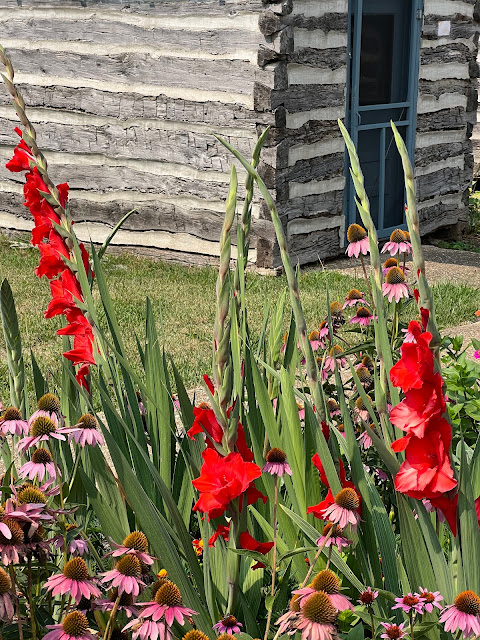
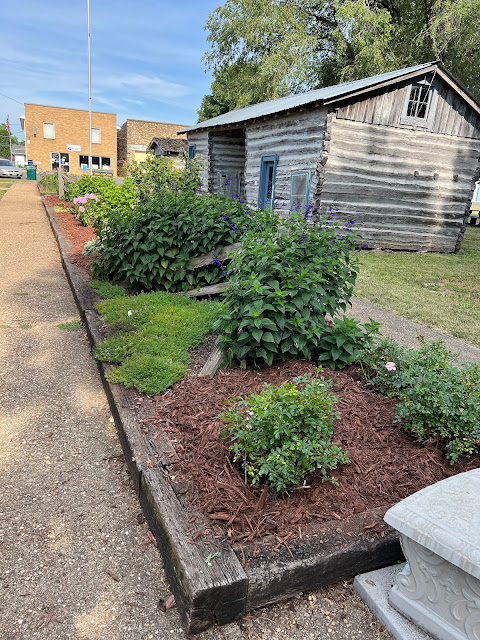









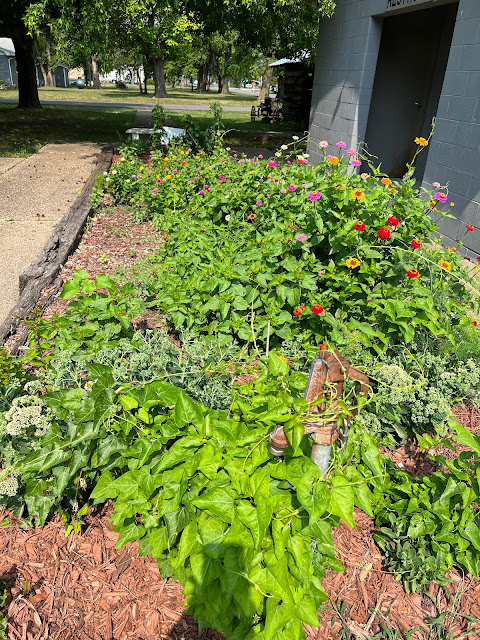
















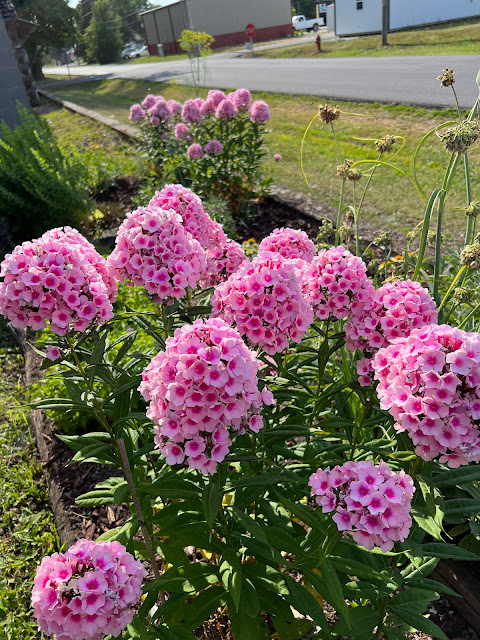






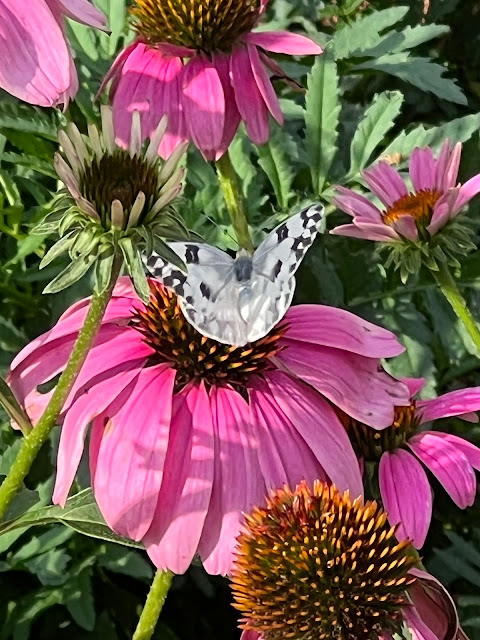




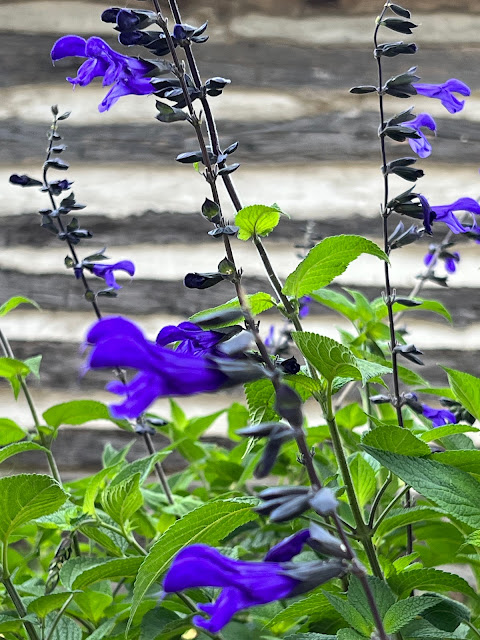












No comments:
Post a Comment